The Winnipeg Whiteout is over early.
After capturing two well-deserved wins against the St. Louis Blues in Games 3 and 4 and drawing even in the first-round series at two games apiece, the Winnipeg Jets lost Games 5 and 6 and their Stanley Cup quest came to an end exactly a month earlier than a season ago.
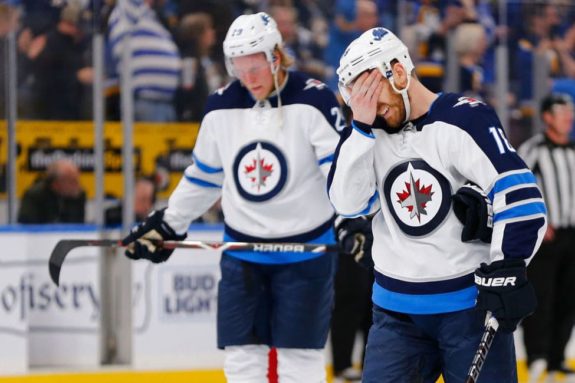
The disappointing first-round exit — after the Jets were considered one of the league’s most compelling Cup contenders all season long — meant the team did not fulfill The Hockey News’ long-ago made prophecy.
Here are the reasons the Jets fell in Games 5 and 6, and ultimately the reasons why they’re going home.
Game 5
Jets Missed Opportunities to Pull Away
Up 2-0 in the second of the pivotal Game 5, the Jets had piles of 10-bell chances to extend their lead, but each time, could not convert. These missed opportunities ended up looming large.
Hayes Robs Himself of a Goal
In the early second, Kevin Hayes engaged in an act of self-sabotage.
The centre, all alone in front after a Blues’ turnover at the blue line, deftly tipped a Mathieu Perreault shot through the pads of Jordan Binnington.
If Hayes had simply left the puck alone, it would have dribbled over the goal line for his second of the game. However, he attempted to poke at it one more time, and in the process, actually swept the puck the opposite way.
It would have been a great defensive play if the puck was behind Connor Hellebuyck instead of Binnington, but as it stood, it prevented the Jets from going up 3-0 and the roof from being blown off Bell MTS Place.
Power Plays Couldn’t Convert
Shortly after, the Jets were handed another golden opportunity to pull away when Robert Thomas was assessed a double-minor for high-sticking Dmitry Kulikov.
In the four minutes that followed, the Jets registered just one shot on goal. Blake Wheeler was unable to get any seam passes through to Mark Scheifele or Patrik Laine, as the Blues’ penalty killers did a good job getting in lanes. A number of shots attempts were also off the mark — way wide.
If anything, killing off the infraction gave the Blues a lift, when it could have been the thing that sunk them.
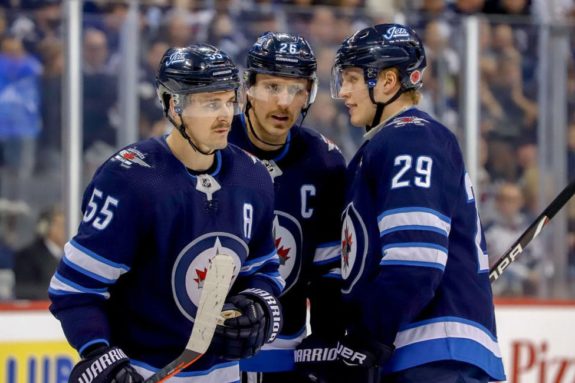
In the third, after the Blues had cut the lead in half, the Jets had the opportunity to regain the two-goal cushion when Joel Edmundson took a delay-of-game penalty. Again, though, the Jets’ power play was anemic.
Hayes Bungles a Breakaway
Oh, what could have been for the Jets in Game 5 if Hayes had converted on one more of his plethora of chances. In the late second, he came in on a breakaway and did a forehand deke, but then it looked like a piston in his brain misfired.

He hesitated before shooting, got in way too tight, and had to resort to trying to bank it in off of Binnington’s pad from below the goal line. Needleless to say, that didn’t come close to working.
Failed Defensive Zone Clearances
The Jets also had every chance in the third period to preserve their lead despite not padding it like they could have. However, their penchant for turning the puck over in the D-zone and failing to dump it out of danger — in Game 5’s third period, the Jets “posted the worst defensive zone turnover rate of any single period, of any team, in the entire playoffs thus far, with 25 per cent of their possessions leading to a turnover in their own zone,” Andrew Berkshire noted — came back to bite them on two occasions. (from ‘Defensive zone turnovers continue to haunt Jets, ‘Winnipeg Free Press, 04/19/19.)
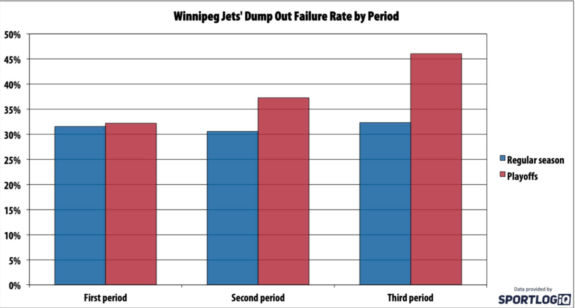
The first was on the Blues’ early-third power play, which had carried over from the second after Jacob Trouba was penalized for roughing with 21 seconds left in that frame. The Jets attempted to clear the puck up the middle, but Alex Pietrangelo kept it in. A few seconds later, the puck was in the back of the net after Ryan O’Reilly banged in a rebound from a Brayden Schenn one-timer.
Trouba & Scheifele’s Last-Minute D-Zone Dumpster Fire
The second failed clearance was even more costly. In the final minute, with the game knotted 2-2, Jacob Trouba had the puck behind the Jets’ net and the chance to execute a straightforward breakout. However, he decided to “eat” the puck instead — that is, pin it along the end boards — in an attempt to run out the clock and force overtime.
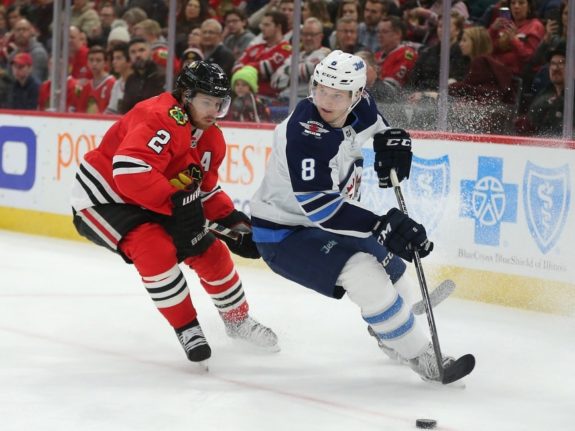
The big problem with that strategy was that there was nearly 30 seconds left on the clock and almost no chance the puck would stay pinned behind the net for that long.
It didn’t, but as head coach Paul Maurice noted, Mark Scheifele actually came out of the scrum with the puck. His backhand up-the-wall clearing attempt, however, was easily stopped by Tyler Bozak, whocentred the puck for Jaden Schwartz, and you know the rest. 3-2 Blues. Nighty night, Jets. Another lead squandered.
Bell MTS Place was as quiet as a morgue, but not because anyone was stunned (at least, they shouldn’t have been). Rather, everyone seemed to know the goal was coming, and were simply depressed their team had blown a third-period advantage for the 11th time this season, and second time in round one alone.
The final minute was simply a comedy of errors and the perfect illustration of how they “seem to fundamentally change the way they play based entirely on the score and the clock,” (from ‘Blown leads enough to give Jets a complex,’ Winnipeg Free Press, 04/19/19.)
Game 6
Jets’ Play Characterized by Complete and Total Lack of Effort
The Jets couldn’t miss their opportunities in Game 6, because quite frankly, they didn’t get any.
Here’s what Mathieu Perreault said before puck drop:
“It’s a do-or-die situation, so you shouldn’t need anything else to get you going. Even experience, I don’t think it matters now. It’s one game where you’ve got to come out and play your best game of the year. Individually, we should all bring our best game. This is the only way we’ve got a chance. It’s desperation time, you should be bringing you’re A-game tonight. Everybody in the room. I’ll bring my A-game and I’m expecting the guy next to me to do that.” (from ‘Backs against the wall, Jets need to find their ‘best game’: Morrissey,’ Winnipeg Free Press, 4/20/19.)
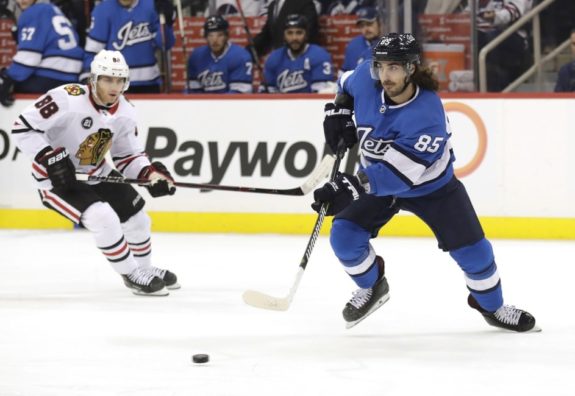
Despite Perreault’s words and plenty of other platitudes coming from the Jets’ dressing room, the only thing Perreault’s squad looked desperate to do was hit the golf course.
They put in a totally lackadaisical, pitiful, and unacceptable performance, looking nothing like the powerful team that rolled out of Games 3 and 4 victors, and instead looking every bit like the team that was listless and lifeless down the stretch in the regular season. It was not only their worst performance of the playoffs — it was their worst performance of the entire 2018-19 season.
“The #NHLJets have the urgency of a grazing cow at the moment,” Scott Billeck quipped at one point. “It’s like the Jets don’t realize their predicament. So casual,” he remarked at another.
A Dejected Squad, Dominated
The Jets’ Game 5 blown lead sapped the team of any will, and it was obvious they could not mentally recover from their demoralizing collapse. The Blues ran roughshod over the visitors from the get-go, dominated the O-zone for nearly the entire game, and looked like they just wanted it more.
The only players who gave a legitimate effort were Dustin Byfuglien, who ran around all over the ice and was described as playing “whatever position he feels like,” and Hellebuyck, who did his best to quell onslaught after onslaught from the Blues with 33 saves.
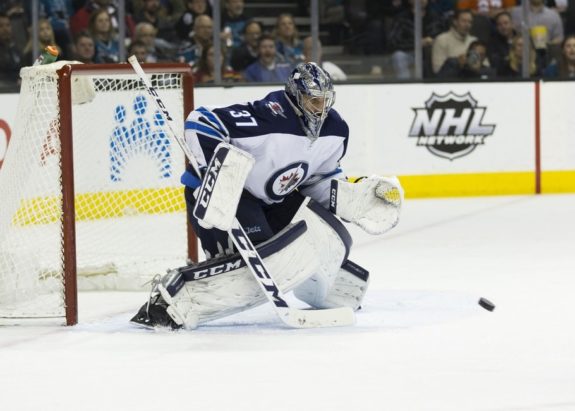
In the second period, the Jets were outshot an almost unthinkable 16-1 — their only shot coming just over 10 minutes into the frame on a Josh Morrissey wrister — but somehow found themselves only down 2-0 after 40. However, Jaden Schwartz completed his hat trick 3:55 into the third to push the lead to 3-0.
That turned out to be the game-winner. In the last 10 minutes, it looked like the Jets finally realized they were playing in an elimination game and turned it on. They managed to cut the Blues’ lead to 3-2 courtesy of goals from Byfuglien and Bryan Little, but the final score flattered the visitors.
Jets Couldn’t Challenge When It Mattered (And Could Have Worked)
Schwartz’s third goal quite likely should have been only his second.
In the second period, he scored on the power play after a mad scramble, but it appeared Pat Maroon had interfered with Hellebuyck by latching onto the goaltender’s glove.
Unfortunately for Paul Maurice, he couldn’t challenge because he’d already wasted his timeout just 23 seconds into the game, challenging Schwartz’s game-opener for goalie interference even though it was obvious he would have no chance of winning it.

A challenge on the second goal likely would have overturned the call on the ice and could have shifted the momentum. But that’s coulda, woulda, shoulda, for a team that’s deservedly heading home.
Important Offseason Ahead
“It’s hard to say what went wrong,” Hellebuyck said after his team was eliminated. “We really shouldn’t point fingers and try to find blame.”
Despite Hellebyuck’s words, it’s necessary for the Jets to find out where the blame lies for their profoundly disappointing early exit and to figure out why the team couldn’t parlay their talent into a deeper run.
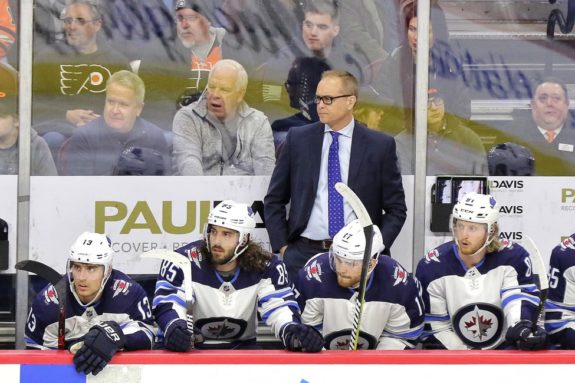
The Jets have plenty to dissect over the coming weeks and months, including whether their coach is the right guy to eventually lead the team to the promised land, whether going all-in and dealing for Hayes at the trade deadline was really the shrewd move this author and many others thought it was, and why they didn’t play anywhere near their potential in the back half of the campaign.
General manager Kevin Cheveldayoff also has plenty of personnel due hefty raises this summer. Laine and Kyle Connor are both restricted free agents, as is Trouba (though Trouba may very well have played his last game in a Jets’ jersey Saturday night.)
Related: Winnipeg Jets Salary Cap Information
Morrissey is due for a contract extension in 2020 and retaining him is an absolute must. Sparkplug forward Brandon Tanev is another glue guy who will be seeking a bump in salary. Retaining everyone and staying cap-compliant will be tougher than a two-dollar steak.

The Jets should still be highly competitive in 2019-20, but it’s tough to take much solace in that right now. A first-round exit is a monumental step back for a franchise with the Jets’ firepower, especially when it’s obvious their path to the Cup will only be more difficult in the seasons to come.